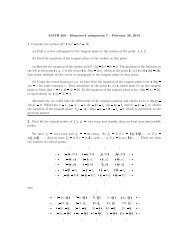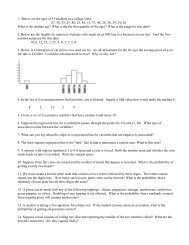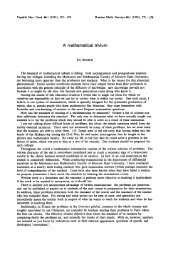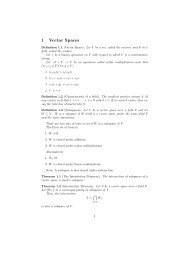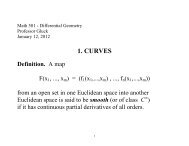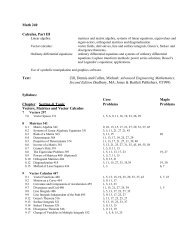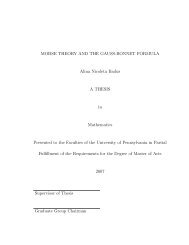Barcodes - Department of Mathematics
Barcodes - Department of Mathematics
Barcodes - Department of Mathematics
You also want an ePaper? Increase the reach of your titles
YUMPU automatically turns print PDFs into web optimized ePapers that Google loves.
6 ROBERT GHRIST<br />
Instead <strong>of</strong> examining the homology <strong>of</strong> the individual terms Ri, one examines the<br />
homology <strong>of</strong> the iterated inclusions ι : H∗Ri → H∗Rj for all i < j. These maps<br />
reveal which features persist.<br />
As a simple example, persistence explains why Rips complexes are an acceptable<br />
approximation to Čech complexes. Although no single Rips complex is an especially<br />
faithful approximation to a single Čech complex, pairs <strong>of</strong> Rips complexes ‘squeeze’<br />
the appropriate Čech complex into a manageable hole.<br />
Lemma 2.1 (de Silva [10]). For any ǫ > 0, there is a chain <strong>of</strong> inclusion maps<br />
(2.2) Rǫ ֒→ C ǫ √ 2 ֒→ R ǫ √ 2 .<br />
(See [10] for the tight dimension-dependent bound smaller than √ 2.) This implies<br />
that any topological feature which persists under the inclusion Rǫ ֒→ Rǫ ′ is in<br />
fact a topological feature <strong>of</strong> the Čech complex Cǫ ′ when ǫ′ /ǫ ≥ √ 2. Moral: the<br />
homology <strong>of</strong> the inclusion ι∗ : H∗Rǫ → H∗Rǫ ′ reveals information that is not<br />
visible from H∗Rǫ and H∗Rǫ ′ unadorned. This is a foreshadowing <strong>of</strong> the broader<br />
idea <strong>of</strong> persistence arising in an arbitrary sequence <strong>of</strong> chain complexes.<br />
2.2. Persistent homology. One begins with a persistence complex: a sequence<br />
<strong>of</strong> chain complexes C = (C i ∗)i together with chain maps x : C i ∗ −→ C i+1<br />
∗ . (For<br />
notational simplicity, we do not index the chain maps x.) This is motivated by<br />
having a sequence <strong>of</strong> Rips or Čech complexes <strong>of</strong> increasing ǫ sampled at an increasing<br />
sequence <strong>of</strong> parameters {ǫi}. Since Rips or Čech complexes grow with ǫ, the chain<br />
maps x are naturally identified with inclusions.<br />
Definition 2.2. For i < j, the (i, j)-persistent homology <strong>of</strong> C, denoted H i→j<br />
∗ (C)<br />
is defined to be the image <strong>of</strong> the induced homomorphism x∗ : H∗(Ci ∗) → H∗(C j ∗).<br />
As an example, consider the filtration R = (Ri) <strong>of</strong> Rips complexes parameterized<br />
by proximities ǫi. Lemma 2.1 implies that if ǫj/ǫi ≥ √ 2, then H i→j<br />
k (R) �= 0 implies<br />
Hk(Cǫj) �= 0. Holes in the Čech complex are inferred by the persistent homology <strong>of</strong><br />
the Rips filtration.<br />
There is a good deal more algebraic structure in the interleaving <strong>of</strong> persistent<br />
homology groups, as explained in the work <strong>of</strong> Carlsson and Zomorodian. Fix a PID<br />
<strong>of</strong> coefficients R and place a graded R[x]-module structure on C with x acting as a<br />
shift map. That is, a unit monomial xn ∈ R[x] sends Ci ∗ to Ci+n ∗ via n applications<br />
<strong>of</strong> x. One assumes a finite-type condition that each Ci ∗ is finitely generated as an<br />
R[x]-module and that the sequence stabilizes in i (in the case <strong>of</strong> an infinite sequence<br />
<strong>of</strong> chain complexes).<br />
As the filtering <strong>of</strong> C is via chain maps x (cf. the setting <strong>of</strong> Rips complexes<br />
— simplices are added but never removed as ǫ increases), C is free as an R[x]module.<br />
The resulting homology H∗(C) retains the structure <strong>of</strong> an R[x]-module,<br />
but, unlike the chain module, is not necessarily free. Nor is it easily classified: the<br />
Artin-Rees theory from commutative algebra implies that the problem <strong>of</strong> classifying<br />
(finite-type) persistence modules such as H∗(C) is equivalent to classifying finitelygenerated<br />
non-negatively graded R[x]-modules. This is known to be very difficult<br />
in, say, Z[x].<br />
However, for coefficients in a field F, the classification <strong>of</strong> F[x]-modules follows<br />
from the Structure Theorem for PID’s, since the only graded ideals <strong>of</strong> F[x] are <strong>of</strong><br />
the form xn · F[x]. This implies the following:



